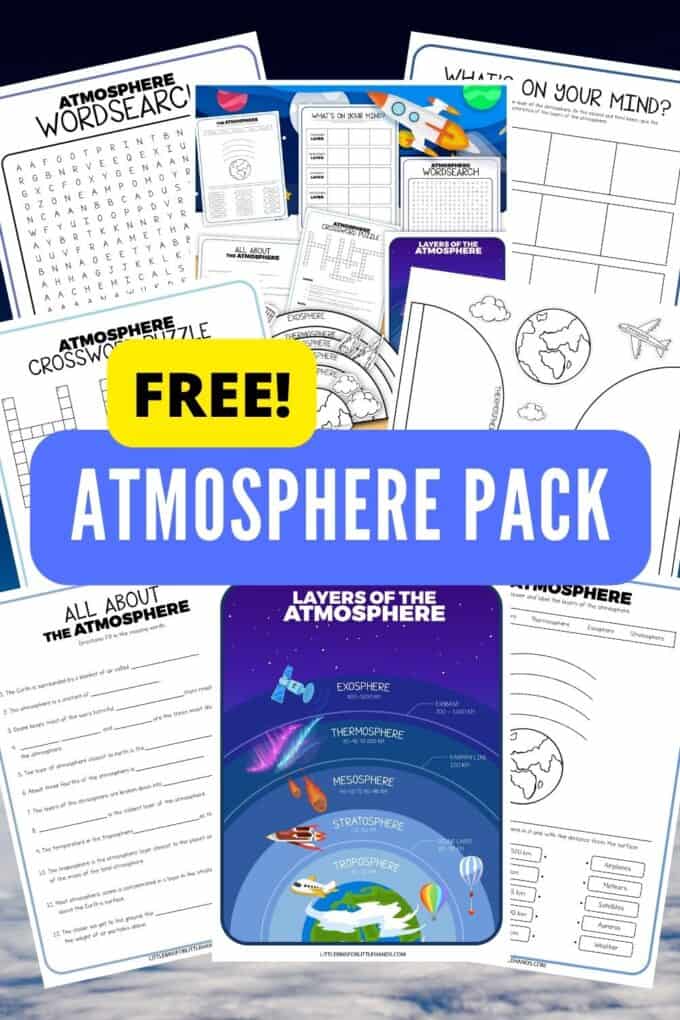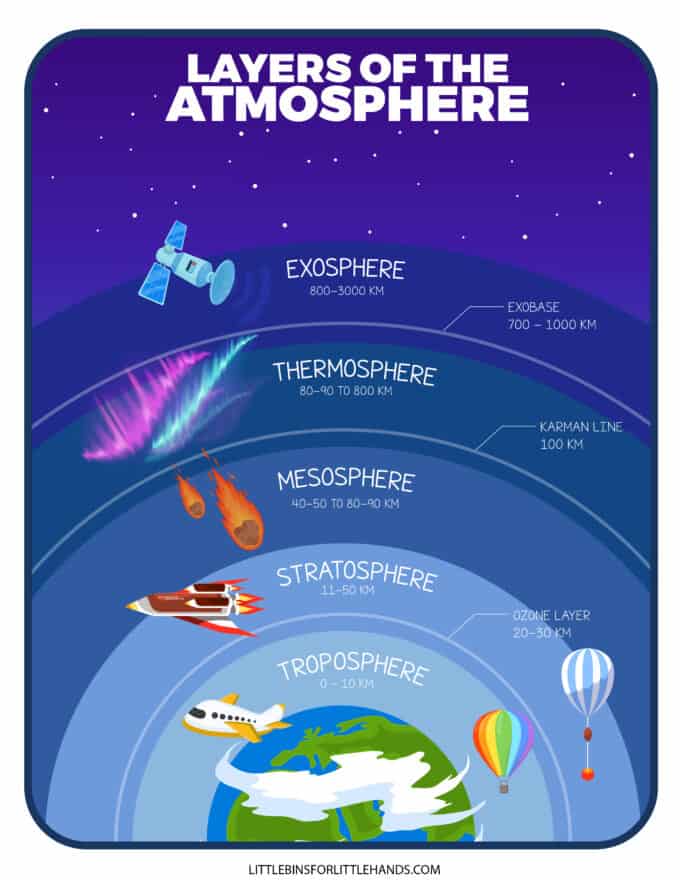Get ready to learn about the Earth’s atmosphere with these fun printable worksheets and games below. An easy way to explore the layers of the atmosphere, and why they are important. Great for an Earth science theme for elementary age kiddos! We have loads of fun earth science activities for kids to try!

Biology, Earth Science, and the Atmosphere
Earth science and biology come together like best friends when we talk about the layers of the atmosphere. Imagine our planet wearing a cozy blanket made up of different layers of air. These layers, known as the troposphere, stratosphere, mesosphere, thermosphere, and exosphere, are like Earth’s invisible neighborhoods.
In Earth science, we learn how each layer has its own special features and how they work together to create the weather we experience every day. Now, here’s where biology joins the adventure!
Find more earth science activities for kids here.
The atmosphere isn’t just air; it’s also where living things, like plants and animals, find the oxygen they need to breathe and live. So, when we study the layers of the atmosphere, we’re not just exploring the skies; we’re discovering the air that keeps our planet and all its living creatures alive and thriving.
Find more biology activities for kids here.
THE LAYERS OF THE ATMOSPHERE
Layers of gases, called the atmosphere, surround the Earth and are held in place by gravity. The atmosphere becomes thinner the greater the distance from Earth, with no clear boundary between the atmosphere and outer space.
Nitrogen gas makes up about three-fourths of the atmosphere. Other main gasses are oxygen, argon, and carbon dioxide.
Learn more about the nitrogen cycle and the carbon cycle here.
Earth’s atmosphere has 5 main layers. The layers of the atmosphere in order from the lowest to the highest are the troposphere, stratosphere, mesosphere, thermosphere, and exosphere.
Each area has different temperature changes, chemical compositions, movement, and density. Read on to find out how they differ from each and what the purpose of each layer is.
Troposphere
The troposphere is the atmospheric layer closest to the planet and contains 75% of the mass of the total atmosphere. It ranges from the Earth’s surface to an altitude of about 10–15 km or 4-12 miles. It also contains 99% of the water vapor and is where the weather occurs. You will notice the temperature in the troposphere decreases as the altitude increases.
The top of the troposphere is called the tropopause.
Stratosphere
Next is the stratosphere, which occurs at 4 to 31 miles or 10 to 50 km. The lower layers of the stratosphere are colder and the upper layers become hotter. It contains warm, dry air and little water vapor, which means it usually has no clouds.
The stratosphere is made up of mainly nitrogen and oxygen. But it also has a layer known as the ozone layer, which contains a high concentration of ozone. This is able to absorb most of the Sun’s ultraviolet radiation. The ozone keeps most of the sun’s harmful radiation from reaching the earth.
The stratopause separates the stratosphere from the mesosphere. It is also considered the top of the stratosphere. Commercial airplanes generally fly in the lower stratosphere because there is less turbulence making for a more enjoyable ride!
Mesosphere
The mesosphere is the third layer of the atmosphere. It extends from about 50 to 85 km or 31 to 53 miles above the Earth. It is the coldest layer of the atmosphere. In fact, the coldest temperatures in the earth atmosphere are found at the top of this layer. The mesosphere is also where most meteors, and space junk, burn up before they can crash to the ground.
Thermosphere
The thermosphere is the fourth layer of the earth’s atmosphere. It is very hot as it absorbs radiation from the sun. The temperature increase is due to the absorption of solar radiation and ultraviolet radiation from the sun. The thermosphere puts on the auroras, amazing light displays in Earth’s sky caused by colliding particles in the top of the thermosphere. The thermosphere is also where satellites orbit the Earth. Even though the word “thermo” means heat, if you were hanging out in this layer, you would be pretty chilly because there aren’t enough molecules to transfer the heat to you! Because there aren’t enough molecules, it’s also hard for sound waves to travel as well.
The ionosphere, although not shown is included in the Thermosphere. This region is full of electrically charged particles called ions and is where most auroras appear such as the Aurora Borealis or Northern Lights, and Southern Lights.
Exosphere
The exosphere is the most outer layer of the Earth’s atmosphere. This layer starts at 500 kilometers above the Earth’s surface and goes to about 10000 KM. It is mainly made up of light gases such as hydrogen, carbon dioxide, and helium. These gases are very spread out with a lot of space in between. They are light enough to escape Earth’s gravitational force and move into space.

LAYERS OF THE ATMOSPHERE WORKSHEETS
Learn about the Earth’s atmosphere with our free layers of the atmosphere worksheets. This printable pdf learning pack includes word search, crossword, fill-in blank, and more.
CLICK HERE TO GET YOUR FREE LAYERS OF THE ATMOSPHERE PACK!
MORE FUN WEATHER ACTIVITIES
See our complete list of weather activities here.
Explore how clouds form with a cloud in a jar.
Investigate what happens to plants when there is acid rain.
Learn how to make a thermometer.
Build a DIY anemometer to measure the direction of the wind.
Set up a water cycle in a bottle or a water cycle in a bag for weather science.
Printable Science Projects For Kids
If you’re looking to grab all of our printable science projects in one convenient place plus exclusive worksheets and bonuses like a STEAM Project pack, our Science Project Pack is what you need! Over 300+ Pages!
- 90+ classic science activities with journal pages, supply lists, set up and process, and science information. NEW! Activity-specific observation pages!
- Best science practices posters and our original science method process folders for extra alternatives!
- Be a Collector activities pack introduces kids to the world of making collections through the eyes of a scientist. What will they collect first?
- Know the Words Science vocabulary pack includes flashcards, crosswords, and word searches that illuminate keywords in the experiments!
- My science journal writing prompts explore what it means to be a scientist!!
- Bonus STEAM Project Pack: Art meets science with doable projects!
- Bonus Quick Grab Packs for Biology, Earth Science, Chemistry, and Physics









